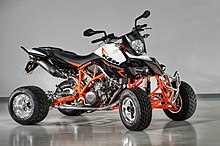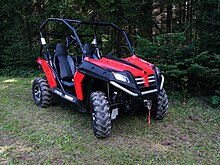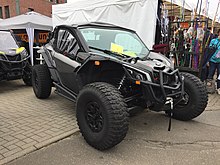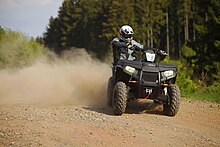Quad


A Quad [ kwɑd ] ( ) (from Latin about quattuor , "four", to quadruplex , "fourfold") or ATV ( ) (short for All Terrain Vehicle , German: "Geländefahrzeug") is a small motor vehicle for one to three people with four wheels or less often with four caterpillar tracks , often with thick balloon tires as an all-terrain vehicle . In Germany, sports and leisure vehicles are often referred to as quads , work vehicles for off-road use, for example mountain rescue vehicles with all-wheel drive , more like ATVs. This distinction does not exist in Canada or the USA.
Designs
The driver's seat on quads and on most ATVs, like on motorcycles, has the shape of a saddle and is steered with a handlebar. The side-by-side vehicles (also known as UTV = utility ATV), which are still rarer up to now and which are derived from ATVs, have seats similar to car seats ; the steering is operated via a steering wheel. ATVs and side-by-side vehicles are used for passenger transportation and reconnaissance in the military for which they were originally developed.
technology
Quads usually have a rigid rear axle that is torsion-resistant to the frame and guided on a swing arm. This type of construction ensures a low inclination in curves. Due to the high center of gravity, the inside rear wheel is relieved. The tire can lose contact with the road. In order to maintain traction , quads do not have a differential gear , otherwise the free wheel would spin. A certain amount of slippage on the rear wheels is necessary with this construction, it only enables the small four-wheel vehicles to corner.
The front wheels of both the quad and the ATV are guided by double wishbones, called A-arms in technical jargon. With the all-wheel drive ATVs, a lockable differential gear is partly installed. In the case of ATVs, independent suspension with double wishbones on the rear axle is now becoming the norm, with limited slip differentials on the rear axle still being the exception.
In ATVs with large balloon tires with low tire pressure, the pressure of the tire on the ground is lower than with a typical quad. This reduces tire wear when cornering. The rear independent wheel suspension enables the two axles to be more closely articulated, which has clear advantages over a rigid axle when working on difficult terrain or on an enduro trail . In motocross sport, this construction method has (so far) no tangible advantages. In addition, an independent suspension is heavier and more maintenance-intensive than a swing arm construction.
In modern sports quads, shock absorbers are used on the front and rear axles to dampen the chassis; the rebound and compression stages are fully adjustable. Many dampers have a separate pressure compensation tank, which is used to hold the oil displaced during compression and also to cool the damper oil. The suspension springs are wound with a variable pitch. As a result, the spring stiffness increases progressively during compression. Alternatively, quads are equipped with air suspension that is up to 3.5 kg lighter.
Most premium brands of sport quads have a rear swing arm made of die-cast aluminum. This is lighter than forged or welded steel swing arms. Together with aluminum wheels, this reduces the unsprung mass on the rear axle. The rear damper is often not connected directly to the top of the swing arm, but is based on a deflection system. This is intended to support the progression of the individual rear damper described above.
The chassis is the most important system group on the quad, far ahead of the engine power. Because if the chassis does not work properly, the engine power cannot be fully used. In addition, the condition of the driver is excessively stressed.
Yamaha offers in its Model 700 Grizzly be the first OEM ( O riginal e quipment M anufacturer) a power steering on. The advantages of electronic power steering are noticeable in this heavy ATV even during normal operation. If the ATV is equipped with a crawler undercarriage, the advantage is very great, since the driver has to apply high steering forces without the power steering.
Quads with disc brakes on the front and rear axles, which are operated hydraulically (via multi-piston brake calipers ) or mechanically (via Bowden cable ), are slowed down, with steel braided brake lines being used in some cases. The drum brake is only used on simple machines. The manufacturers Kawasaki and Yamaha are going a different way with an encapsulated oil bath multi-disc brake on the rear axle of some of their ATVs and the KFX700.
The frames of the higher quality sports quads are made of torsion-resistant steel and aluminum, there are also frames made of aluminum.
For racing purposes, Nerf bars (protective bars ), steering dampers, a reinforced steering column and handlebars, a "kill switch", ie a tear-off cord to an emergency stop switch , all sorts of engine tuning parts and widened A-arms and rear axles can be installed.
Motorization
The motorization of the vehicles is currently between 50 cm³ and 1000 cm³ with an output of up to 50 kW. There are also special designs with a displacement of up to 1150 cm³ and a turbocharger. The engines are usually four-stroke single-cylinder, although there are also models with four-stroke two-cylinder, two-stroke engines and diesel engines . For mixture preparation, electronic injection systems are used in newer models instead of carburettors in order to improve the performance and smoothness of the engines and to reduce pollutant emissions.
With quads, the drive force is usually transmitted to the rear axle by a chain, while ATVs with switchable all-wheel drive mostly have cardan drive. The gear ratio can only be changed with a great deal of effort with the cardan drive, with the chain drive you only need to exchange the front sprocket and rear chainring. This is an important aspect for sports drivers who want to adapt their quad to the respective race track.
As with motorcycles, footshifting is common on quads. Most machines also have a reverse gear, with the exception of sport quads, which are intended for racing use on the motocross track. They are not used for weight reasons. When engaging the reverse gear, a lock must be overcome in order to reliably avoid accidental engagement. In recent years, simple quads have been equipped with stepless, automatic V-belt drives (CVT, continuously variable transmission ). This has been standard for ATVs for years. As a rule, there is a low and high gear as well as a neutral gear and a park position. As with automobiles, sports drivers are very skeptical about automatic shifting, which is why the number of sports quads with CVT transmissions is small.
For safety reasons, a thumb throttle is used on the vehicles as well as on jet skis or snowmobiles . A throttle twist grip can be retrofitted, but this makes precise gas metering difficult because of the relatively high steering forces. Especially when the driver shifts his weight, the risk of accidentally accelerating increases significantly. There are also combinations of twist grip and thumb throttle, with which the driver can switch to the concept that suits him for off-road and road.
history
In Germany, the “Ur-Quad” is usually called the Kraka (short for power carts ), which was developed in Germany in 1962 by the Zweirad Union company for use in agriculture and forestry. After the dissolution of the Zweirad-Union, the Faun company took over and modified the Kraka and made it usable for the Bundeswehr. Another “Ur-Quad” is the US Army's M274 Mechanical Mule (1957). The airborne troops used these vehicles as air-transportable weapon carriers. The successor to the Kraka was the armored weapon carrier Wiesel . Quads are used by the Special Forces Command (KSK) as vehicles analogous to motorcycles for fast off-road use and for connection purposes, since they can be driven with a class B driving license and the driver training is not as complex as for a class A driving license.
The forerunner of the quads in the recent past were originally from Honda developed three-wheeled all-terrain (motor) cycles (ATC). Also Yamaha (including "Tri-Z") and Kawasaki (including "Tecate") set out in this field of expertise. The main market was the USA , and this is where the vehicles appeared first. The tricycles were initially only intended as recreational vehicles for the southern California deserts. The engine power is transmitted to a rigid rear axle without a swing arm, on which most of the driver's weight is also supported. When you accelerate, the front wheel is so relieved that steering movements are not transferred to the ground. A chassis suspension was not initially installed. Instead, balloon tires offered a certain amount of suspension. The consequences of this very simple construction and the inexperience of the drivers resulted in numerous serious accidents in the USA. The media picked up the topic. The consumer protection organization CPSC (Consumer Product Safety Commission) finally, in agreement with the manufacturing industry (Honda, Kawasaki, Suzuki , Polaris Industries , Yamaha) pushed through the end of the production of the tricycles at the end of the 1980s, but no sales ban. The agreement was valid for 10 years from 1987 on. In order to make driving safer and ultimately also because of the lucrative sales market, the Suzuki company developed the first four-wheel "quad", the Suzuki LT 125 . Other manufacturers followed a little later with four-wheeled products. In addition to the leisure and sport use (publications in the then still existing 3Wheeler magazines reached millions of ATC drivers), the quads were also discovered by farmers for work on their large pastures, then as a useful transport vehicle. But the quad continues to gain acceptance, especially as a piece of sports equipment, and official quad championships are now being held in many countries.
The main market today for the quads / ATVs is still North America with around one million units per year. But the markets in South America, Australia and Europe have also developed lucratively for manufacturers. Europe is playing an increasingly important role , especially for Polaris, Can Am and Arctic Cat .
Street legal
The vehicles are usually imported into Europe as pure all-terrain vehicles and have to be converted by the importers or dealers at great expense for road approval. When retrofitting, headlights, indicators, brake lights, parking lights and speedometer are installed in accordance with EC standards. Road safety can be increased by widening the track , lowering the vehicle and using road tires.
The basis for the classification of quads is guideline 92/61 / EEC, which in addition to three-wheeled vehicles up to 45 km / h also includes four-wheeled light vehicles (max. 45 km / h and not more than 50 cm³) and four-wheeled vehicles (more than 45 km / h) km / h and more than 50 cm³). However, the directive restricts four-wheel vehicles to a maximum output of 15 kW with a maximum empty weight of 400 kg. Vehicles with higher performance are no longer covered by Directive 92/61 / EEC. They can therefore only be registered as a car or as an agricultural and forestry tractor. However, approval as a car often fails due to the inaccessible noise limit of 74 dB.
With a second main lighting system and a trailer hitch with socket, mainly the expiring code "No. 8700 tractor "applied. As a result, no emissions test is necessary and environmental zones can be entered without a sticker.
There are also quads that are built as street quads from the start, so that the expensive conversion is not necessary. They generally have a wide track, road tires, a low center of gravity, and a low rider and passenger seating position. Many entry-level machines up to 300 cm³, especially those from Taiwanese manufacturers such as Kymco , Adly , SYM , Dinli or SMC, are supplied as standard with COC papers (EU homologation) and attachments that comply with EU standards. Approval as a VKP (four-wheeled vehicle for passenger transport) is possible. The COC papers are valid throughout the EU, so that e.g. B. a machine with first approval in Germany after being sold in another EU country can also be approved there. This is not possible with a tractor approval. Furthermore, a front license plate must be attached in Germany. By definition, quads are not "two-wheelers", so a class B driving license (car driver's license) is required in Germany . Due to the sharp increase in the number of registrations, the German class S driving license was introduced on February 1, 2005 , which also allowed 16-year-olds to drive quads with a displacement of up to 50 cm³ (insurance number). However, the national driving license class S was abolished on January 19, 2013 with the implementation of the current driving license directive and the driving license of this class was included in the harmonized EU driving license class AM .
insurance
Germany
Quads up to 50 cm³ are not subject to registration and only have an insurance label.
There are four categories of insurance for vehicles and quads that require registration:
- Quad with car approval
- Quad with VKP approval (four-wheeled vehicle for passenger transport)
- Quad with LOF approval - with black license plates
- Quad with LOF approval - with green license plate and agricultural use.
Even if the majority of insurers only insure quads with registration types 1/2/3 via WKZ 031 (quad), there are also insurers who insure these vehicles under WKZ 003 (motorcycle). This can lead to significant premium differences. Especially with quads with registration form 1 (quads with car registration) it can happen that these vehicles are insured as cars with the WKZ 112 and are therefore significantly more expensive than comparable vehicles with quad registration. Advantages of quad insurance according to WKZ 031: Most motor vehicle insurers offer the option of classifying a second vehicle if a car is already insured with the insurer. Others even go a little further here: for an improved second vehicle classification, they just want a car to be insured with some insurer in a higher no-claims class.
A few months ago it was still possible to insure quads with LOF approval (LOF = agricultural tractor) via WKZ 452 (agricultural tractor with black license plate). But here, too, the majority of motor vehicle insurers have put a stop to it by now requiring insurance via WKZ 031. However, it is important that an eVB for an agricultural tractor is presented to the registration office when the quad is registered, otherwise there is usually no registration. Quads with LOF approval that have a green license plate and are used in agriculture can still be insured with some insurers via WKZ 451 (agricultural tractor with green license plate), which leads to a considerable premium advantage.
Austria
In Austria, quads with a capacity of up to 50 cm³ can be driven as mopeds with a red license plate from the age of 15 and with a moped pass (additional multi-lane vehicle) Have a driver's license . Therefore, they are also the type of approved label (one or two lines) by car, truck and tractor in exchange indicator sign. If it is one that has still been registered as a tractor, a class "F" driver's license is sufficient and you must drive from 16 years of age, it must not be faster than 50 km / h.
Switzerland
The quads are approved as small motor vehicles regardless of the cubic capacity, provided their total weight does not exceed 0.4 tonnes and they have an engine output of no more than 15 kW (Art. 15 Para. 3 of the Ordinance on the Technical Requirements of Road Vehicles [VTS] ). At least a category B1 driver's license is required to drive these vehicles . Furthermore, holders of a driving license of categories B (cars) as well as categories A (motorcycles over 11 kW power) or A1 (motorcycles up to and including 125 cm³ and 11 kW power) can also drive quads. Helmets have been compulsory since February 1, 2006.
The brake lever on the handlebars will be modified for Swiss approval so that it acts on all four wheels, with a braking force distribution of 60% at the front and 40% at the rear.
Spain
In Spain, quads up to 50 cm³ from 14 years of age can be driven with a moped driving license. A class B driver's license is sufficient for all more powerfully motorized quads. The applicable EU law (helmet obligation only if it is entered in the vehicle registration) is of no interest here. In Mallorca, the number of registrations of quads is increasing rapidly, especially of highly motorized machines (400–750 cm³).
safety
Driving behavior

Quads and especially ATVs are usually designed as off-road vehicles and, due to the ground clearance required for off-road driving, have a high center of gravity, which leads to instability in curves and when driving on slopes (uphill and downhill, cross-slope). A posture adapted to the driving situation, e.g. B. shifting the whole body into the curve instead of just the shoulder, reduces the risk of tipping over. Instead, the quad / ATV should tilt outwards in a controlled manner under the driver's body, so that the inside wheel of the rear axle loses contact with the road. So the quad drives through the curve with three wheels. The slip of a rear wheel through the rigid rear axle supports cornering considerably. If this technique is not used consciously, the driver can be surprised and lose control when cornering quickly.
Strong acceleration can relieve the load on the front axle, making the vehicle no longer steerable.
In the meantime, more and more brands are also delivering road quads as a so-called Supermoto conversion as standard. These are optimized for driving on the road in terms of chassis, track width and center of gravity.
Typical accidents
The special technical characteristics of the quad also determine how accidents occur in these vehicles. For example, a study conducted by insurers ' accident research shows that a missing differential combined with a lack of driving experience poses major problems for the driver when cornering. Leaving the lane when cornering and then colliding with an obstacle next to the lane is a typical occurrence for quad accidents. The very high proportion of single accidents with these vehicles is also noticeable . In general, the risk of being killed or seriously injured in a quad accident is increased by a factor of 10 compared to a car.
Helmet compulsory
Since January 1, 2006, helmets have been mandatory for all drivers and passengers of quads in Germany . "Anyone who drives motorcycles or open three- or multi-wheel vehicles with a design-related top speed of over 20 km / h and rides on or in them must wear a suitable protective helmet while driving." Ordinance to amend the road traffic regulations passed. For vehicles from 2006 this is always included in the papers.
In Austria, since October 2002, all four-wheeled vehicles with a design speed of more than 25 km / h, which have the characteristics of a motorcycle due to the handlebars, operating and display elements and the bench, are compulsory for all quads and ATVs regardless of their displacement.
In addition to the helmet, an approved first aid kit and a warning triangle must also be carried. Since ATVs and quads are mostly approved as VKP and are therefore treated the same as a car, a "motorcycle first aid kit" is not sufficient here. The first aid kit must meet the requirements in the legal text.
Existence in Germany
The total number of 118,054 light four-wheel motorcycles in Germany as of January 1, 2017 by manufacturer:
| Manufacturer | units | proportion of |
|---|---|---|
|
|
27,144 | 23.0% |
|
|
10.122 | 8.6% |
|
|
7,044 | 6.0% |
|
|
5,201 | 4.4% |
|
|
4,497 | 3.8% |
|
|
4,414 | 3.7% |
|
|
3.135 | 2.7% |
|
|
2,791 | 2.4% |
|
|
2,440 | 2.1% |
|
|
2,301 | 1.9% |
|
|
2,169 | 1.8% |
|
|
1,968 | 1.7% |
|
|
1,882 | 1.6% |
|
|
1,742 | 1.5% |
|
|
1,735 | 1.5% |
| Others | 39,469 | 33.4% |
| All in all | 118.054 | 100.00% |
This means that more than half of the quads registered in Germany come from Taiwanese manufacturers.
Competitions and events
In motorsport there are the following competition categories and racing series (selection):
- Motocross (German Quad Cup, Motocross Series North, Motocross Series South, Hessen Cup)
- Enduro (Bergland-Enduro-Cross Cup)
- ATV-Trail (German Championship in Quadtrail)
- Supermoto (IQC - International Quad Challenge)
- Shorttrack (MEFO Sport Shorttrack Quad Cup)
- Royalty free races (BQC - Bavarian Quad Challenge, XCC - Cross Country Championship, Int.Quad & ATV Snow Speedway, Kymco Cup, Baja 300 Central Germany)
Magazines
Web links
Individual evidence
- ↑ Appendix 3 of the 35th BImSchV, exceptions to the labeling requirement according to § 2 Paragraph 1 (to § 2 Paragraph 3)]
- ↑ Quads in accidents
- ↑ § 35h StVZO
- ↑ kba.de FZ 17 (accessed on May 7, 2017)









